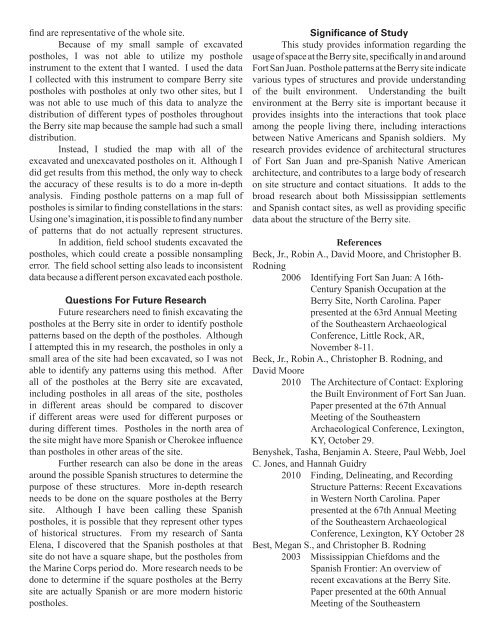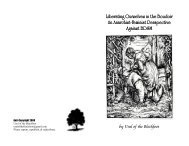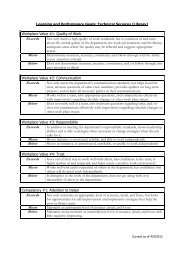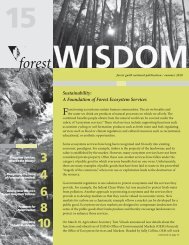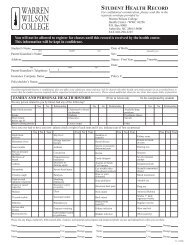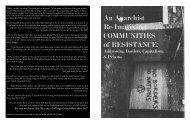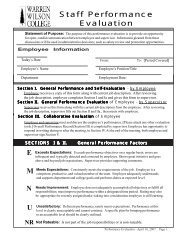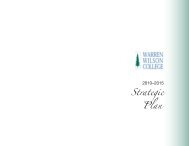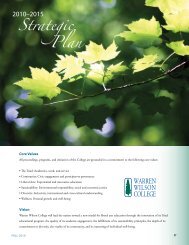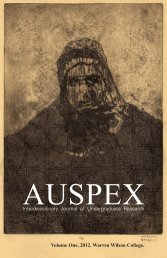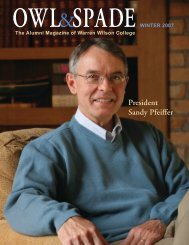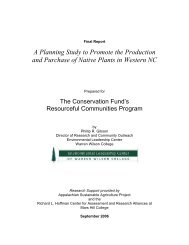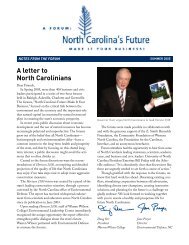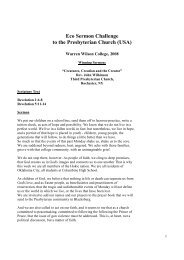Native American and Spanish Ancillary Structures - Warren Wilson ...
Native American and Spanish Ancillary Structures - Warren Wilson ...
Native American and Spanish Ancillary Structures - Warren Wilson ...
Create successful ePaper yourself
Turn your PDF publications into a flip-book with our unique Google optimized e-Paper software.
find are representative of the whole site.<br />
Because of my small sample of excavated<br />
postholes, I was not able to utilize my posthole<br />
instrument to the extent that I wanted. I used the data<br />
I collected with this instrument to compare Berry site<br />
postholes with postholes at only two other sites, but I<br />
was not able to use much of this data to analyze the<br />
distribution of different types of postholes throughout<br />
the Berry site map because the sample had such a small<br />
distribution.<br />
Instead, I studied the map with all of the<br />
excavated <strong>and</strong> unexcavated postholes on it. Although I<br />
did get results from this method, the only way to check<br />
the accuracy of these results is to do a more in-depth<br />
analysis. Finding posthole patterns on a map full of<br />
postholes is similar to finding constellations in the stars:<br />
Using one’s imagination, it is possible to find any number<br />
of patterns that do not actually represent structures.<br />
In addition, field school students excavated the<br />
postholes, which could create a possible nonsampling<br />
error. The field school setting also leads to inconsistent<br />
data because a different person excavated each posthole.<br />
Questions For Future Research<br />
Future researchers need to finish excavating the<br />
postholes at the Berry site in order to identify posthole<br />
patterns based on the depth of the postholes. Although<br />
I attempted this in my research, the postholes in only a<br />
small area of the site had been excavated, so I was not<br />
able to identify any patterns using this method. After<br />
all of the postholes at the Berry site are excavated,<br />
including postholes in all areas of the site, postholes<br />
in different areas should be compared to discover<br />
if different areas were used for different purposes or<br />
during different times. Postholes in the north area of<br />
the site might have more <strong>Spanish</strong> or Cherokee influence<br />
than postholes in other areas of the site.<br />
Further research can also be done in the areas<br />
around the possible <strong>Spanish</strong> structures to determine the<br />
purpose of these structures. More in-depth research<br />
needs to be done on the square postholes at the Berry<br />
site. Although I have been calling these <strong>Spanish</strong><br />
postholes, it is possible that they represent other types<br />
of historical structures. From my research of Santa<br />
Elena, I discovered that the <strong>Spanish</strong> postholes at that<br />
site do not have a square shape, but the postholes from<br />
the Marine Corps period do. More research needs to be<br />
done to determine if the square postholes at the Berry<br />
site are actually <strong>Spanish</strong> or are more modern historic<br />
postholes.<br />
Significance of Study<br />
This study provides information regarding the<br />
usage of space at the Berry site, specifically in <strong>and</strong> around<br />
Fort San Juan. Posthole patterns at the Berry site indicate<br />
various types of structures <strong>and</strong> provide underst<strong>and</strong>ing<br />
of the built environment. Underst<strong>and</strong>ing the built<br />
environment at the Berry site is important because it<br />
provides insights into the interactions that took place<br />
among the people living there, including interactions<br />
between <strong>Native</strong> <strong>American</strong>s <strong>and</strong> <strong>Spanish</strong> soldiers. My<br />
research provides evidence of architectural structures<br />
of Fort San Juan <strong>and</strong> pre-<strong>Spanish</strong> <strong>Native</strong> <strong>American</strong><br />
architecture, <strong>and</strong> contributes to a large body of research<br />
on site structure <strong>and</strong> contact situations. It adds to the<br />
broad research about both Mississippian settlements<br />
<strong>and</strong> <strong>Spanish</strong> contact sites, as well as providing specific<br />
data about the structure of the Berry site.<br />
References<br />
Beck, Jr., Robin A., David Moore, <strong>and</strong> Christopher B.<br />
Rodning<br />
2006 Identifying Fort San Juan: A 16th-<br />
Century <strong>Spanish</strong> Occupation at the<br />
Berry Site, North Carolina. Paper<br />
presented at the 63rd Annual Meeting<br />
of the Southeastern Archaeological<br />
Conference, Little Rock, AR,<br />
November 8-11.<br />
Beck, Jr., Robin A., Christopher B. Rodning, <strong>and</strong><br />
David Moore<br />
2010 The Architecture of Contact: Exploring<br />
the Built Environment of Fort San Juan.<br />
Paper presented at the 67th Annual<br />
Meeting of the Southeastern<br />
Archaeological Conference, Lexington,<br />
KY, October 29.<br />
Benyshek, Tasha, Benjamin A. Steere, Paul Webb, Joel<br />
C. Jones, <strong>and</strong> Hannah Guidry<br />
2010 Finding, Delineating, <strong>and</strong> Recording<br />
Structure Patterns: Recent Excavations<br />
in Western North Carolina. Paper<br />
presented at the 67th Annual Meeting<br />
of the Southeastern Archaeological<br />
Conference, Lexington, KY October 28<br />
Best, Megan S., <strong>and</strong> Christopher B. Rodning<br />
2003 Mississippian Chiefdoms <strong>and</strong> the<br />
<strong>Spanish</strong> Frontier: An overview of<br />
recent excavations at the Berry Site.<br />
Paper presented at the 60th Annual<br />
Meeting of the Southeastern


